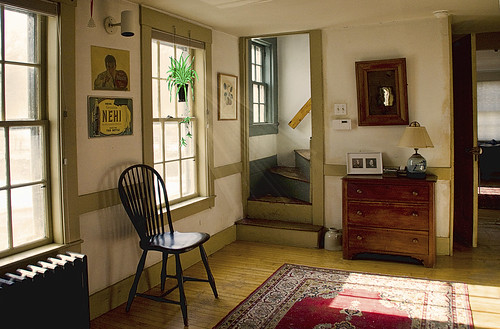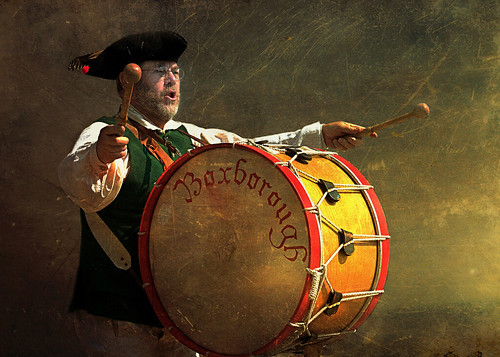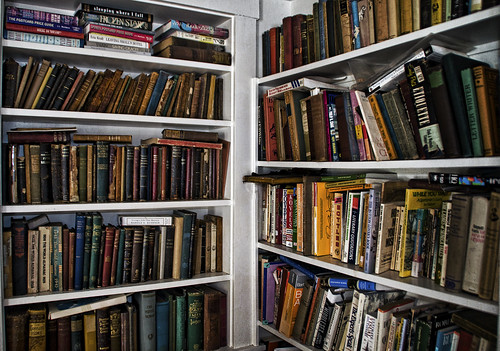
The farm didn’t get television until I was almost grown. Consequently, I spent a lot of time finding ways to amuse myself. I read, I drew, I explored, I rode my horse, and I lay in a hammock strung between two pear trees and daydreamed. I was always more solitary than my brother and liked to lose myself in various projects. I still do. In fact, that solitary spirit probably defines where I live.
I live in a series of concentric, overlapping worlds, like those diagrams that children draw when they’re around 8 or 10. They place themselves in the center, and then draw larger and larger circles to signify their streets, their towns, their states, their country, their continent, their planet, and finally the universe. My concentric circles don’t really include the universe, but they do contain me, my home, my neighborhood, my town, my state, my country, and the world.

Life & Imagination Intersect
Liz West

However, one set of circles isn’t really enough for me, since the place I live includes both the past and the present of all of those places on the diagram. I have a mind that jumps around associatively. Although I try to be very present in daily life, I am always aware of the past, which permeates my life. I live in an old farmhouse now, surrounded by meadows. A cousin once visited me and pointed out that I had recreated in Massachusetts my childhood home in Pennsylvania. In a way, I think I have. The houses certainly feel much the same.
I am very affected by places and loved this house on sight. When I moved in, I planned on spending my life here, and I probably will. I still remember the first time I drove down my country road after buying the house. I looked at the beautiful landscape and wondered how long before it felt like home. I also hoped that familiarity would never blind me to the natural beauty all around me. It has not. Every day that I wake up here, I am grateful for my surroundings.
This is an old house, and it has some drawbacks. Occasionally, these bother me. Most of the time, though, I am smitten by the personality of the house and by the environment that it provides. Light pours in through large windows, and time feels fluid.
My senses strongly influence my responses to locales, and sensory details register in my consciousness. I delight in my morning cup of coffee, for instance, made with fragrant fresh beans, and served steaming hot in a yellow mug. I love how the morning sun hits the red carpet in my hallway, and how the first floor, made of hardwood, feels different from the second floor, which is old pine.

I have lived in my present home for more than 40 years, so my own history is part of this house along with that of earlier owners. Three generations of one family lived here before me, and I enjoy that knowledge. I sleep in a four-poster bed they left behind and, every day my feet navigate the stair treads that were worn by their family and mine.
My birth family also feels present in my home. I have many pieces of furniture from my parents’ and grandparents, as well as artwork and photographs. These items make me feel securely connected to different generations, near and far, living and dead.
I also feel connected to the history of the town. I worked for decades as a town volunteer, recognizing that my fortunes and those of my children were intimately tied to those of the town. I co-authored a history book about Boxborough and later published a local newspaper that recorded present-day history. I still take photographs of local events, recognizing that this small town has a distinct personality that should be treasured.
I have always felt a strong link to both the past and the present. Perhaps it has something to do with growing up in old houses. But it might also be the result of spending a life surrounded by stories of ancestors, antiques, and books.

I still remember (and own) the first “adult” book that I read. It was called The White Lady, and it was written by a naturalist about an albino bat. I still own many of my childhood books, and it is from them that I developed my love of illustrations. To me, the illustrations were more than just pretty pictures. For example, one day, when my daughter was home sick, I began reading to her from my old copy of Heidi. The book is set in the Swiss Alps, and my copy of the book had full-color illustrations showing the mountains and meadows. As I turned a page, my jaw dropped, because there was a picture of a sunny meadow that I was sure I had seen at my childhood farm. I just knew that I had been in that meadow. Later, I realized that the illustration was so meaningful to me, that I had incorporated it into my own memory as if I had experienced it first hand. In a way, I had.

My interior world is as rich as my external world. I think people who comfortably live alone spend a lot of time inside their heads. I know that I do. I ponder, I make up stories, I invent illustrations for things that exist only in my head. The real world is a springboard for my creative one.
I not only take pictures but also create images of a world that doesn’t actually exist outside of my imagination. When I was younger, I wanted to be a cartoonist or an illustrator. However, I didn’t have the facility for drawing the types of images that I liked. Now I use photographs to create illustrations of a world that’s not actually real, even though its parts are.
Last summer, I took a road trip through Pennsylvania and took hundreds of photographs. Many triggered memories of places from my childhood or from book illustrations. Although I processed only a few dozen of the pictures, the rest stayed in my mind. A few days ago, I saw a hand colored photograph of a drum major that captured my attention. It resonated because it instantly reminded me of another photo that I owned. Both made me recall a house picture I had taken last summer.
Suddenly, everything came together and I imagined an entire scene. Just as historical novels blend real people and places with a fictional world, so do many of my images. In them, I can have real people, places, and objects living an existence that I would like them to have. Reality, nostalgia, and imagination intersect.
I think that intersection is where I really live. It is a conceptual place, rather than a concrete one. It combines the past and the present, the real and the imaginary, and all the sensory information from both places. It’s where I feel most fully at peace.